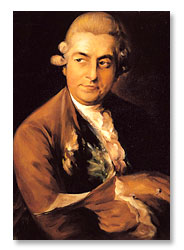 J.S. Bach
J.S. Bach(excerpts from the book, Bach, Beethoven and the Boys by David Barber)
Bach's possessions included six claviers, a lute and several other instruments; a variety of candlesticks; two silver coffee pots, one large, one small; a silver teapot; and assorted pieces of furniture. He also had three different coats (the silk one was somewhat worn, he says) and 11 linen shirts "at the wash." He probably picked them up before he left town.
At the St. Thomas School, Bach was expected to teach the boys music, Latin, and grammar, while leading "a sober and secluded life." He hired a man named Petzoldt to teach his Latin classes for him.
[Ed. note: Bach wasn't the first choice of the Leipzig town authorities for the job. Telemann was their first choice, because he was a graduate of the school and his music was more "modern." The second choice was one Christoph Graupner, also a graduate of the St. Thomas School. (Ever heard of him?) Both men were competent, but neither could obtain release from their current posts. It says something about the state of affairs at that time. What existed were the remnants of the old Medieval guild system - there definitely were publicly recognized musical standards. However this was combined with an interesting form of graft: 1) marry my daughter, or 2) make a "contribution," or 3) be a part of the old boys network, etc. They didn't fully realize what they had in Bach.]
Bach was busy at Leipzig. When not disciplining small boys he found the time to compose nearly 300 cantatas, the B minor Mass, and his mighty St. Matthew Passion. In his spare moments he composed other things. His old temper hadn't left him: when the university officials turned down Bach's application to compose a special piece of music and gave the job instead to a man named Gorner, Bach tossed his wig at him and said he would have made a better cobbler. Bach's salary at the school was 700 thaler a year, with extra money to lead the choir for funerals.
The school's old rector died, and was replaced by Johann August Ernesti. He was one of those progressive types who didn't care for music much. He used to call the boys in the school orchestra "pot-house fiddlers," which was bad for morale. [Ed. note: I also read that he called them "beer fiddlers."] Bach spent more and more time travelling around the country-side trying out new organs, as an excuse to get away.
In his last years, Bach was nearly blind and his health was declining. It was all he could do to jot down the first 239 bars of the last fugue of The Art of Fugue, the most amazingly complicated fugal composition ever written. An English oculist, John Taylor, attempted surgery on Bach's eyes but it did no good: the operation left him completely blind [Ed. note: the same oculist operated on Handel, I believe, with the same effect. He traveled around with all of his equipment and assistants in several covered wagons with big eyes painted on them - pretty creepy!] Suddenly on July 18, 1750, Bach's eyesight was miraculously restored, but he suffered a stroke and died 10 days later.
Anna Magdalena never remarried and tried to struggle along on a measly pension. She died ten years after her husband and was buried in a pauper's grave. Wilhelm Friedemann did pretty well as a composer and recitalist. One source tells us that "he had a beautifully shaped long-fingered hand." Carl Philip Emanuel worked for Frederick the Great, King of Prussia. Frederick liked to play the flute, but took liberties with the tempo. C.P.E. just played along and said nothing. After all, Frederick was the king. Johann Christian moved to London and wrote operas. [Ed. note: However before this he spent considerable time in Italy and converted to Catholicism - an effect Italy tends to have on some people. He studied with Mozart's counterpoint teacher, Padre Martini, and met and befriended the young Mozart.]
J.C. Bach is pictured above.
There were other Bachs but none of them amounted to much. Bach's grandson, Johann Sebastian II, was a painter, but you can't get ahead that way. By May of 1871, historian Sanford Terry says, "Bach's blood had ceased to flow in mortal veins."
No comments:
Post a Comment